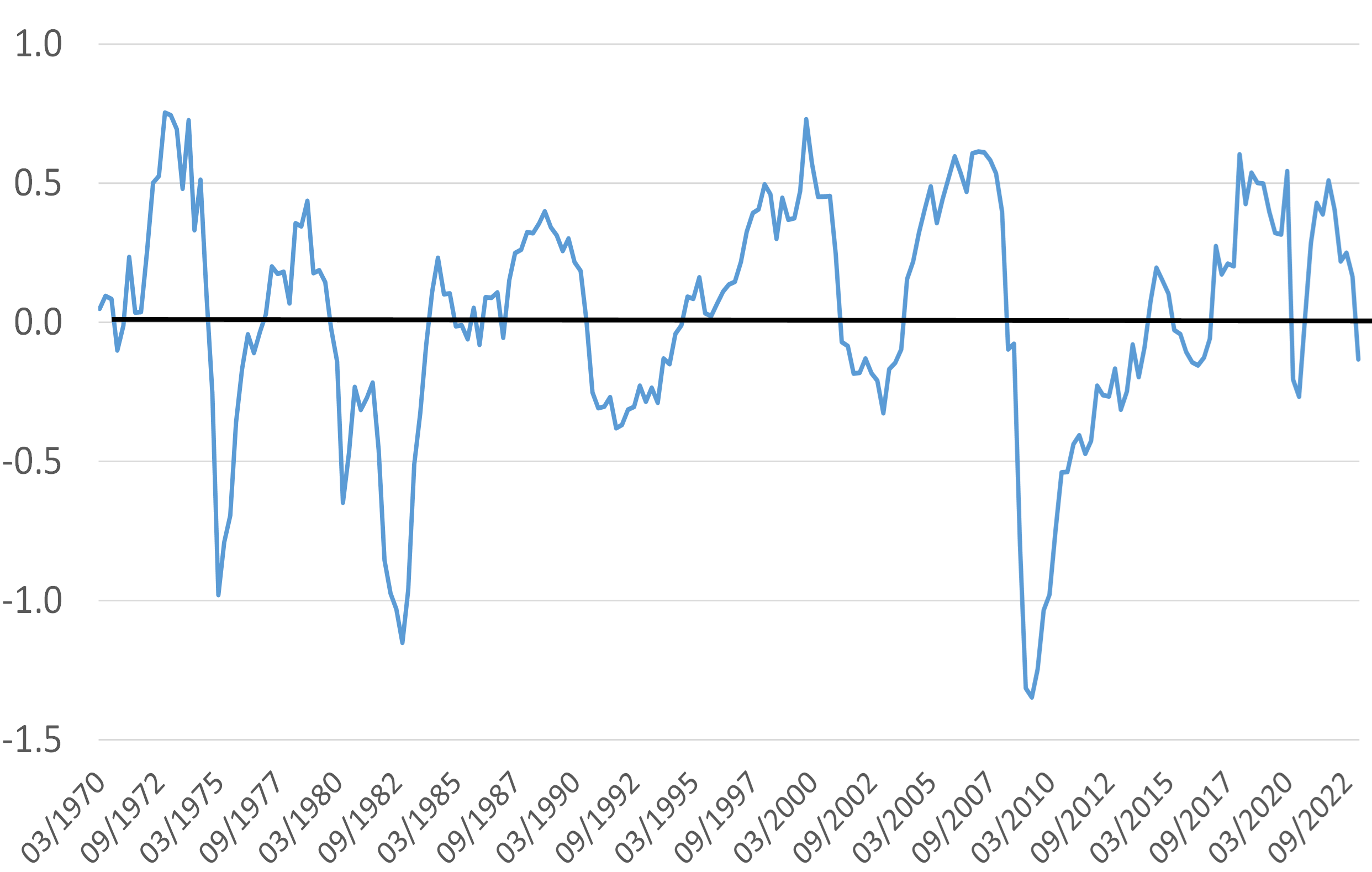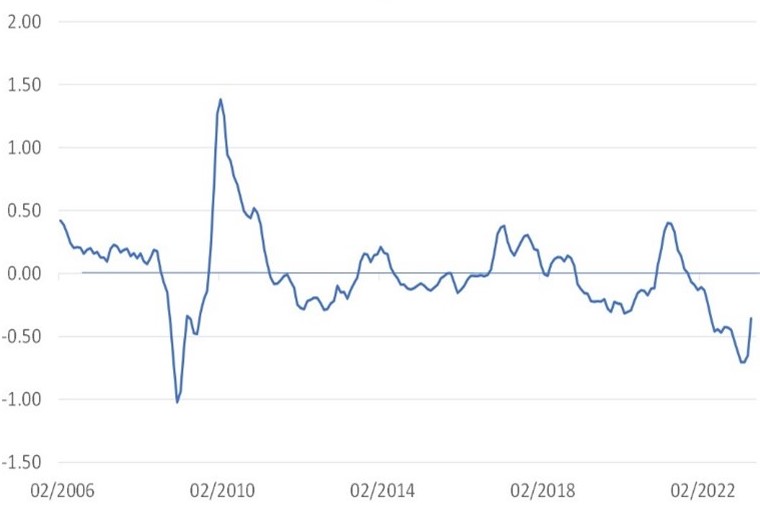There was quite simply nothing not to like about the latest US consumer price index data; not only was the headline a good number but so too were most of the internals. Non-durable goods price inflation is cooling, durable goods prices fell back following a brief rally and they will probably deflate further as Asian Deflation feeds through, the housing terms have become better behaved, and (despite a slight tick up over the last month) energy prices are helping, at least for now.
The decline in the rate of inflation was perhaps to have been expected. Two months ago, we noted that our long-running “Demand Pressure Index“ (DPI) has dropped to virtually zero during the first quarter, thereby indicating that the rate of inflation should be stable or even subsiding a little. Since we compiled this first estimate, there have been a number of significant component data revisions that suggest that the DPI was in fact negative during the first quarter. Aggregate demand of course rose during 2023Q1 but it is evident that supply (particularly in the labour and goods markets) grew by relatively more.
USA: Demand Pressure Index
1970 - 2023Q2e

Although we only have partial data available at this time, we have nevertheless attempted a flash estimate for the DPI for Q2, and this suggests a quite significantly negative reading, thereby implying that the economy has significant spare capacity and a negative output gap. On this basis, the FOMC should not only cease their rate hikes but perhaps reconsider their stance vis-à-vis Quantitative Tightening. It seems to early to expect Powell to change course but presumably he will before too long.
Perhaps the more pertinent question for investors at this juncture is whether the inflation rate is now only passing through this 2-percent-and-a-bit sweet spot? Just as the economy was only very briefly at its optimal “zero” level of demand pressure in January on its way to something weaker, it is possible that inflation might also be heading to too low a rate. If the Federal Reserve continues to tighten, and to be honest we are more concerned about continued QT rather than another quarter point on the Fed Funds, it is quite possible that the economy could overshoot into a deeper than necessary recession.
Such an event would of course bring down reported inflation further – and might even return some prices to their pre-pandemic levels (which seems to be an objective for some politicians) - but there would be costs in terms of lost output, reduced employment, and a deep profit recession. We might also expect a wave of credit events under such circumstances.
Markets have evidently decided that the economy is going to have a soft / no landing, although to be honest we suspect that this expectation is based more on their own recent performance than economic data. Certainly, tax credits and slower inflation provided a boost to consumer demand and even trade trends towards the end of the first quarter, but this seems to be fading as wage income growth slows and the stock of excess savings begins to diminish.
Meanwhile, across the Pacific, China’s economy looks to be moving from “a disappointing recovery narrative” to something more serious. We cannot construct a Demand Pressure Index for the PRC – there simply is not enough reliable data available but we do use our “Gravity Index” as a substitute.
China: AHEL Gravity Model
average - 0

The Gravity Index works by attempting to quantify China’s economic impact on the economies around it – we use third party rather than PRC data - and the results from this seem quite unequivocal and clearly more than a little consistent with the experiences of most of China’s trading partners and, of course, its recent deflationary numbers.
The Gravity Index has rebounded from its late 2022 lockdown-induced lows but it clearly remains verry weak. We remain convinced that the Balance of Payments-derived constraint on the PBoC’s ability to ease has resulted in credit trends within the economy being well below the threshold amount necessary to support growth (we estimate that credit availability is only two thirds of what would be needed to revitalize the “old economy” and, like all highly indebted economies that suffer credit rationing, the impact has been significant on both growth and the price level). Of course, the impact of China’s problems has spread well beyond its own geographic borders and in particular within the Asian Region.
Finally, over the last fortnight, we have conducted a number of Euro Zone reviews and if there is an abiding theme, it is that despite an easier fiscal stance, a mercurial funding strategy employed by some governments, and even quite strong inflows of capital, the Euro Zone economies have nevertheless fallen prey to a recession and they are continuing to experience not only weak income trends but remarkably weak monetary trends. However, the ECB appears determined to continue tightening.
In 2020, central banks – perhaps understandably - eased too aggressively during the Crisis Phase of the Pandemic. In 2021, they unfortunately continued to run with accommodative policy settings even as inflation returned. Initially in 2022 they were reluctant to tighten, but once the magnitude of their 2021 mistakes became all too evident, and the political narrative shifted to the “War on Inflation”, they swung 180 degrees and began competing to see who could be the most hawkish.
Over recent weeks, they have continued this hawkish bias even as not just recorded inflation rates but underlying inflationary pressures have subsided. It may well be that the strength in risk markets and financial sector leverage has been leading them astray. Clearly, the last three years have seen central banks frequently and consistently fighting last year’s war and, if they continue in this vein, then a deep global recession awaits at the end of this year once the US and other countries have finally burnt through what remain of their pandemic-era household savings. From boom in 2021 to bust in late 2023 – stop-go is back it seems. At present, it seems to us that the brakes may be being applied too firmly but next year we wonder whether e will move back to “excessive go”…
Disclaimer: These views are given without responsibility on the part of the author. This communication is being made and distributed by Nikko Asset Management New Zealand Limited (Company No. 606057, FSP No. FSP22562), the investment manager of the Nikko AM NZ Investment Scheme, the Nikko AM NZ Wholesale Investment Scheme and the Nikko AM KiwiSaver Scheme. This material has been prepared without taking into account a potential investor’s objectives, financial situation or needs and is not intended to constitute financial advice and must not be relied on as such. Past performance is not a guarantee of future performance. While we believe the information contained in this presentation is correct at the date of presentation, no warranty of accuracy or reliability is given, and no responsibility is accepted for errors or omissions including where provided by a third party. This is not intended to be an offer for full details on the fund, please refer to our Product Disclosure Statement on nikkoam.co.nz.



